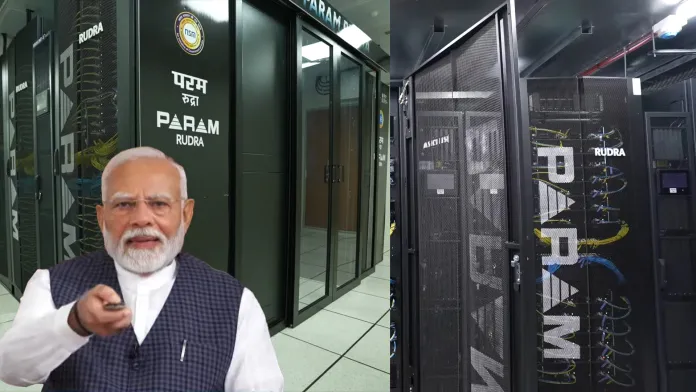When you hear the term “supercomputer,” what comes to mind? Something massive, packed with incredible power, handling computations that regular machines could never dream of. In today’s world, supercomputers are the engines behind cutting-edge research, advancements in technology, weather forecasting, and so much more. And guess what? India is leading the charge with its PARAM series of supercomputers, particularly the PARAM Rudra.
Now, let’s dive deep into what makes PARAM Rudra so special, how it fits into the broader history of India’s computing advancements, and why it matters to you and me.
What is PARAM Rudra?
PARAM Rudra is one of India’s latest developments in the world of supercomputing. It’s part of the prestigious PARAM series, which has been instrumental in putting India on the map for high-performance computing (HPC). Developed by the Centre for Development of Advanced Computing (C-DAC), PARAM Rudra is designed to support the growing need for computational power across a range of industries, including scientific research, defense, and education.
The name “PARAM” actually stands for “Parallel Machine” in Sanskrit, which makes sense because supercomputers work by parallel processing—handling thousands or even millions of calculations at the same time.
A Glimpse into the PARAM Legacy
Before we talk more about PARAM Rudra, let’s step back and see how India got here. India’s journey into supercomputing began in the late 1980s. At that time, global powers like the U.S. were leading the supercomputing space, and India needed its own machine for strategic reasons, especially for weather forecasting, space research, and defense applications.
In 1987, the U.S. denied India access to its supercomputers because of concerns around dual-use technology (meaning tech that could be used for both civilian and military purposes). Instead of being disheartened, India decided to take matters into its own hands and develop its own supercomputing technology. Thus, the PARAM series was born, and in 1991, India unveiled its first supercomputer, PARAM 8000.
Since then, PARAM has evolved through several versions: PARAM 10000, PARAM Yuva, PARAM Yuva II, and now, PARAM Rudra.
Why is PARAM Rudra Important?
Supercomputers like PARAM Rudra are critical for several reasons:
- Scientific Advancements: Whether it’s understanding climate change, mapping genomes, or analyzing cosmic phenomena, supercomputers handle massive datasets and simulations that regular computers can’t. PARAM Rudra supports Indian researchers by giving them the computational power to push the boundaries of scientific knowledge.
- National Security: In fields like cryptography, defense simulations, and advanced weapons systems, the sheer processing power of a machine like PARAM Rudra provides India with a strategic advantage.
- Economic Growth: High-performance computing (HPC) is the backbone of technological innovation, and supercomputers like PARAM Rudra help industries such as pharmaceuticals, finance, and manufacturing optimize their processes, ultimately boosting economic output.
- Education and Skill Development: PARAM Rudra is also available for academic institutions and research labs, which means students and young researchers get to work on real-world, high-impact projects. This not only enhances their skills but also builds a tech-savvy workforce for the future.
Technical Specs: What Makes PARAM Rudra a Beast?
Now, let’s talk about what’s under the hood. PARAM Rudra is not just another computer; it’s built to perform on an entirely different scale. Without getting too technical, here are some of the key specs:
- Processing Power: PARAM Rudra delivers more than 1.3 petaflops of computing power. (1 petaflop = 1 quadrillion floating-point operations per second!) That’s a mind-boggling number of calculations per second.
- Storage: It’s designed with a robust storage system that allows for the fast read/write speeds required for handling massive datasets. In fields like genomic research or weather prediction, this kind of storage capability is a game-changer.
- Energy Efficiency: Despite its immense power, PARAM Rudra is built to be energy-efficient, which is a huge plus considering the environmental impact of running large-scale data centers.
- Scalability: One of the coolest things about PARAM Rudra is its modular design. This means it can be scaled up or down depending on the needs of the user, making it versatile for a variety of industries and research needs.
Use Cases: Where PARAM Rudra is Making a Difference
Supercomputers like PARAM Rudra aren’t just sitting around waiting for the next big discovery—they’re actively contributing to multiple fields. Here are a few real-world examples of where PARAM Rudra is making an impact:
1. Climate Modeling
Climate change is one of the biggest challenges facing humanity today, and understanding it requires detailed simulations. PARAM Rudra is helping scientists create complex climate models that predict weather patterns, study the effects of global warming, and even develop strategies for mitigating environmental damage.
2. Healthcare and Genomics
In the field of genomics, researchers analyze DNA sequences to find links between genetic makeup and diseases. This requires processing terabytes of data—something PARAM Rudra is perfectly equipped to handle. By helping to speed up research in this area, it could lead to breakthroughs in personalized medicine and more effective treatments for diseases.
3. Aerospace and Defense
From satellite simulations to designing next-gen aircraft, PARAM Rudra plays a role in advancing India’s aerospace capabilities. Its ability to simulate various scenarios in a highly accurate manner helps engineers and scientists test out designs and systems before they’re built or deployed.
4. Academic Research
Several universities and research labs in India now have access to PARAM Rudra, allowing them to tackle complex problems that require vast computational resources. Whether it’s working on the next big breakthrough in physics or improving AI algorithms, students and researchers are benefiting from the supercomputer’s power.
The Future of Supercomputing in India
PARAM Rudra represents a significant milestone, but it’s only one step in India’s journey toward technological self-reliance. The National Supercomputing Mission (NSM), which was launched in 2015, aims to build a robust ecosystem of supercomputers across the country. With plans to develop over 70 high-performance computing facilities across India, the NSM is setting the stage for a future where India doesn’t just participate in global innovation but leads it.
Final Thoughts: Why Should You Care?
You might be wondering—why does a supercomputer like PARAM Rudra matter to me, an everyday person? The truth is, the research and developments made possible by machines like this will affect us all, from healthcare innovations to better weather predictions to new technologies that will change how we live and work.
Supercomputers are more than just machines for scientists and engineers. They are tools for progress, shaping the future in ways we can’t always see but will definitely feel.
As India continues to push forward in supercomputing with PARAM Rudra and beyond, we can expect to see even more exciting developments that will impact not just the country but the entire world.







